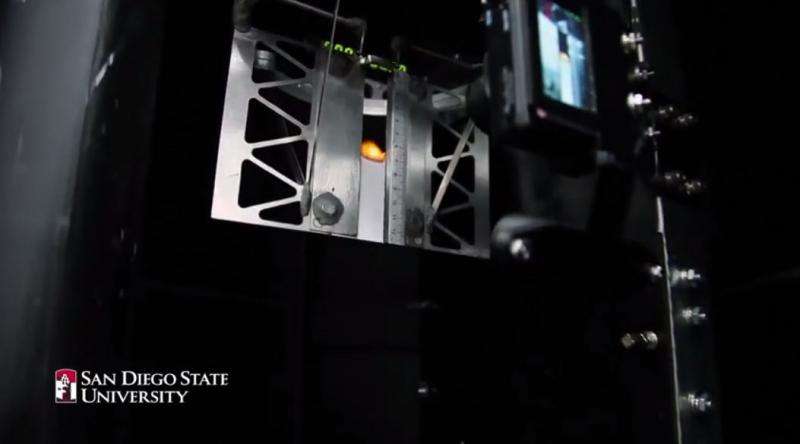The weird ways fire behaves in space (w/ Video)

Light a match on earth and you can expect the flame to shoot up in a tapering bulb. But light that match in space and you might not even recognize the small, blue orb at the tip. That's because fire behaves very differently in low- and zero-gravity environments.
Discovering how the mechanisms of combustion differ in a gravity-free environment is the goal of San Diego State University mechanical engineers Subrata Bhattacharjee and Fletcher Miller, and it could lead to safer space travel and a more complete understanding of fire on earth.
Up and down
Buoyancy plays an integral role in flames on earth, as hot combustion gases rise upward and suck in oxygen to feed the flame anew.
"Buoyancy creates all the dynamics of flame as we know it," Bhattacharjee said. "But in space, there's no up or down. Products from a burning flame can, in some cases, accumulate around the flame, starving it of oxygen, while in other cases, diffusion can sustain a flame in microgravity."
On earth, our atmosphere is about 21-percent oxygen, but engineers can regulate the oxygen aboard spacecraft. High oxygen levels can lead to extremely flammable conditions, as seen in the fatal Apollo 1 disaster. Knowing how fire will behave at different levels of oxygen in low- and zero-gravity environments will make future missions safer.
Bhattacharjee and Miller explore this in a few different ways. They have constructed an 8-meter tall steel flame tower with a vertical rail inside. By placing a fuel sample in a cart, igniting it, then moving it up the tower at a controlled speed, they can negate the effects of buoyancy when the flame travels upward at about the same speed as its gaseous products.
"We are simulating the surroundings that the flame would find in space," Miller explained.
Limiting height
In another experiment, they burn flames in a narrow channel, suppressing its buoyancy by limiting its height.
Using a camera in both tests, they observe how the flame spreads under various conditions, simulating a spacecraft or lunar atmosphere. Eventually, the duo hopes to develop an elegant, simple formula for predicting where fire will go in a variety of conditions and environments.
Another set of experiments takes place 250 miles above their heads. In 2011, NASA invited the researchers to send up materials to the International Space Station for a series of controlled burns in sustained microgravity. Miller and Bhattacharjee have sent up various thicknesses of acrylic and astronauts have burned them in a specially designed chamber while the SDSU researchers observed and offered control suggestions from a video uplink.
Results from these experiments will help the researchers refine their theories about flame dynamics and help NASA qualify materials as safe for use on spacecraft.
Provided by South Dakota State University





















